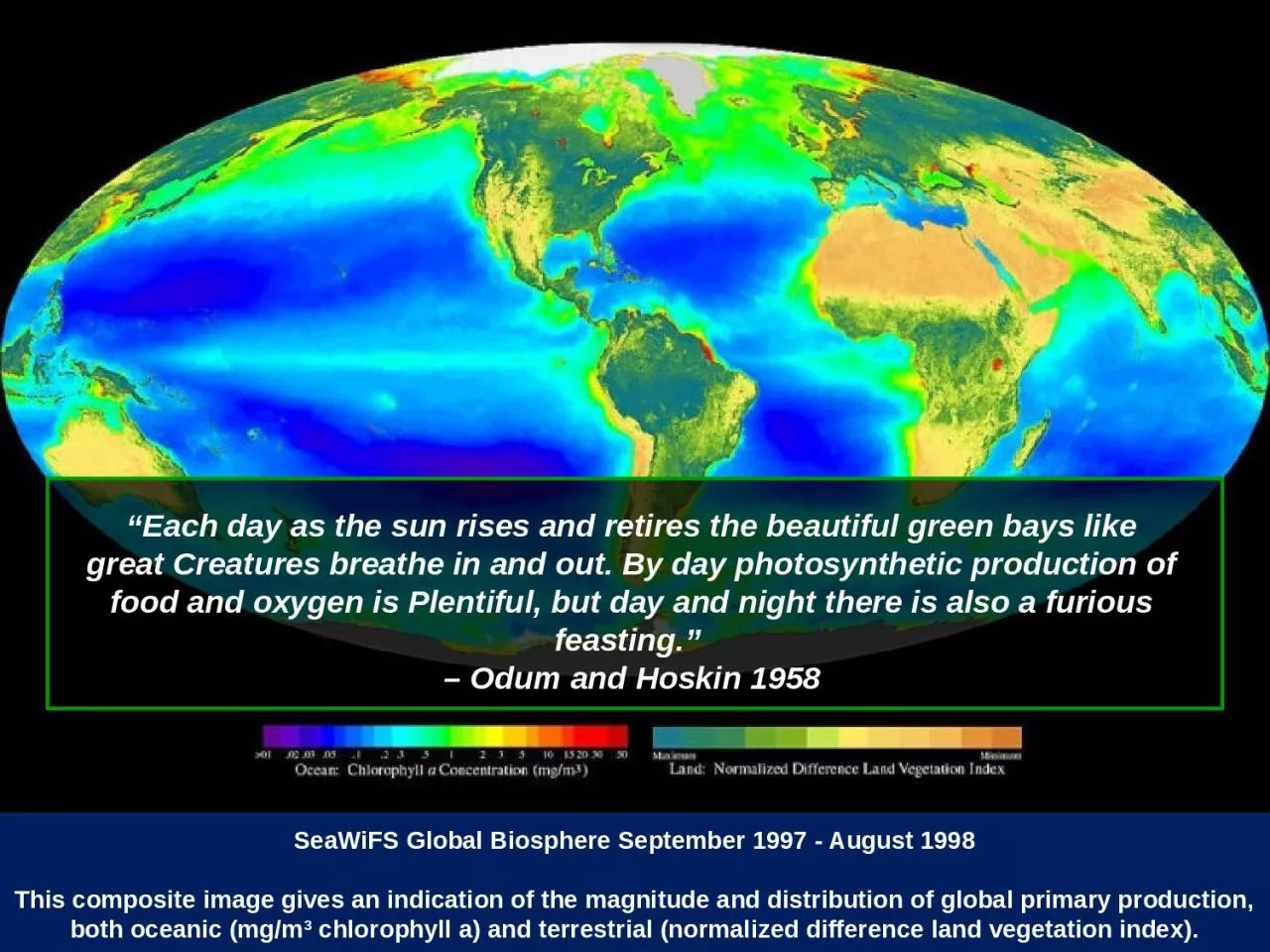

This composite image gives an indication of the magnitude and distribution of global primary production both oceanic mgm 3 chlorophyll a and terrestrial normalized difference land vegetation index ID: 1022290
Download Presentation The PPT/PDF document "SeaWiFS Global Biosphere September 1997..." is the property of its rightful owner. Permission is granted to download and print the materials on this web site for personal, non-commercial use only, and to display it on your personal computer provided you do not modify the materials and that you retain all copyright notices contained in the materials. By downloading content from our website, you accept the terms of this agreement.
1. SeaWiFS Global Biosphere September 1997 - August 1998This composite image gives an indication of the magnitude and distribution of global primary production, both oceanic (mg/m3 chlorophyll a) and terrestrial (normalized difference land vegetation index).“Each day as the sun rises and retires the beautiful green bays like great Creatures breathe in and out. By day photosynthetic production of food and oxygen is Plentiful, but day and night there is also a furious feasting.” – Odum and Hoskin 1958
2. 2Primary productivity in temperate oceans
3. 3Primary productionPrimary Production: Organic matter synthesized from inorganic substances.Photosynthesis: producing organic matter from carbon dioxide and water using Light energy.Carbon dioxide + Water + Light Organic matter + Oxygen 6CO2 + 6H2O + Light C6H12O6 + 6O2Photosynthesis consumes CO2 and produces O2
4. Key Terms:Biomass – static measure of how much, e.g. – how many grams?Primary Production – dynamic measure of how much is(made) produced per unit time, e.g. – how many grams per day?
5. Controls on primary productivityPhotosynthetic light.Dissolved inorganic nutrients.Grazing by zooplankton.
6. What limits primary production in the ocean?Most common limiting factors:LightNutrients
7. The photic zone is the depth where light is sufficient for photosynthesis.The dysphotic zone is where illumination is too weak for photosynthesis.The aphotic zone receives no light from the surface because it is all absorbed by the water above.
8. UltravioletInfraredEuphoticZonePAR: photosynthetic active radiation(400-700 nanometers)
9. 1% light level
10. Major nutrients?Carbon: important but abundant in seawater.Nitrate (NO3-), Nitrite (NO2-), Ammonium (NH4+)Phosphate (PO43-)Silicate (SiO4)106CO2 + 16NO3- + PO43- + 122H2O + 19H+ + Light (CH2O)106(NH3)16(H3PO4) + 138O2Redfield ratio C:N:P = 106:16:1 (in phytoplankton) Diatoms?C:N:P:Si 106:16:1:16
11. Justus von Liebig“Father of Fertilizer Industry” (May 12, 1803 - April 18, 1873)1855: Liebig’s Law of the Minimum: By the deficiency or absence of one necessary constituent, all others being present, the soil is rendered barren for all crops to the life of which that one constituent is indispensable. With equal supplies of the atmospheric conditions for the growth of plants, the yields are directly proportional to the mineral nutrients supplied in the manure. In a soil rich in mineral nutrients, the yield of a field cannot be increased by adding more of the same substances"
12. Leibig’s Law of the Minimum (for oceans):Phytoplankton growth is determined by the response ofphytoplankton to the single factor that is most limiting.These factors include N, P, Fe, Si, and other trace materials.
13. Source of nutrients: Continents. weathering, farm fertilizers runoff wastewater treatment plants….What are sources of nutrients to ocean?
14.
15. Primary production by phytoplanktonCO2phytoplanktonCO2Surface OceanNutrients +
16. What are the products of respiration?OxygenCarbon dioxide and nutrientsOrganic matterI don’t know
17. RespirationOrganic Matter + O2 CO2 + NO3 + PO4 + H2ORespiration (remineralization, regeneration, degradation) consumes oxygen.produces carbon dioxide.regenerates nutrients.
18. Marine SnowSinking particles collected in a sediment trapFecal pelletsPlanktonic testswww.whoi.edu/oceanus
19. Let’s draw…….What would a profile of O2 w/ depth look like?How about dissolved inorganic nitrogen?Depth, m[O2]Epi-pelagic zone ~1000
20. Nutrient remain high, O2 high – because it’s replenished with High oxygen cold water from polar regions….75% of oceanDepleted by photosynthesisRemineralization
21. Vertical distribution of nutrientsDepleted in surface water, abundant in deep waterPO4NO3Si
22. When do you get a phytoplankton bloom???Why do we care?
23. Photosynthesis decreases exponentially with depth due to decrease in light availabilitySverdrup's Model of Critical Depth Respiration is unaffected by light and remains constant with depth
24. Sverdrup's Model of Critical DepthDepthRespiration ratePhotosynthesis rateEuphotic zone~100mToo much light including harmful UV prohibits photosynthesis
25. Sverdrup's Model of Critical DepthDepthRespiration ratePhotosynthesis rateEuphotic zone~100mOperationally defined as The depth at which 1%Of surface light occurs.Compensation Point:Rate of Photosynthesis = Rate of Respiration
26. Phytoplankton is mixed by turbulence and experiences different light intensities over time, sometimes above and sometimes below compensation pointSverdrup's Model of Critical Depth Critical depth = depth at which photo-synthesis of the TOTAL water column phytoplanktonpopulation equals their TOTAL respiration
27. Sverdrup's Model of Critical DepthDepthRespiration ratePhotosynthesis rateEuphotic zone~100mA phytoplankton bloom –can only occur if mixing is shallower than this depth…..shallower than the critical depth. Only then is the population net production >0Critical Depth:TOTAL Photosynthesis =TOTAL Respiration
28. Low latitude: strong thermocline stratified.High latitude: vertically well mixed.DepthTemperatureLow latitudeHigh latitudeMixing
29. Polar oceans: Nutrients are abundant due to vertical mixing.limited by sunlight: darkness for winter months.(partly) covered by sea ice.Primary productivity
30. 30Primary productivity in temperate oceans
31. 31Primary productivity
32. How might we measure photosynthesis in the ocean?
33. Measurements of photosynthesisMonitoring O2 change in a dark bottle and a light bottle. (dissolved oxygen is easy to measure)Light bottle: Photosynthesis – Respiration.Dark bottle: Respiration only.Gross photosynthesis: Light bottle – Dark bottle.Light bottle Dark bottlePhotosynthesis & RespirationRespiration
34. Measurements of photosynthesis Monitoring 14C uptakeAdd dissolved 14C spike.After time duration, filter particles (organic matter produced).Measure 14C incorporated into particles.FYIRadioactivity of 14C is easy to measure when the concentration is VERY high (14C spike).Measurement of natural level is harder (one 14C out of a trillion 12C in nature).
35. 35Chlorophyll (Biomass measurement): Pigments that absorb sun light (blue and red ends of the visible spectrum).Can be monitored by fluorescence (in-situ instrument) and ocean color (satellites)www.succulent-plant.com Measurements
36. Stn A, 2000mStn C, 3500mStn B, 3000mChlorophyllDepth (m)Subsurface Chl. max.
37. Productive along the continents.Productive in the upwelling regions.Deserts in centers of gyres (due to downwelling).Chlorophyll